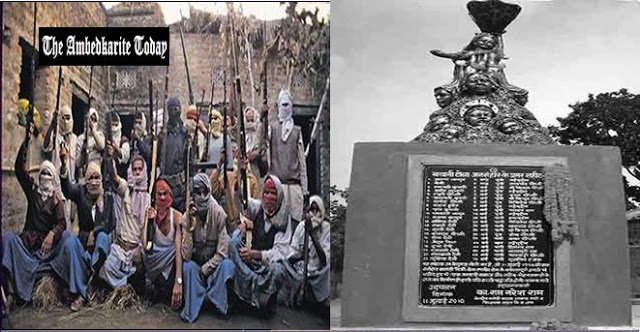On July 11, 1996, the Ranvir Sena, the dreaded private army of upper-caste Bhumihar and Rajput landlords, marched from Barki Kharaon towards Bathani Tola armed with swords and guns and killed eight children, 12 women and one man. Most of the victims belonged to families of Dalit and Muslim landless agricultural labourers
The 1996 Bathani Tola massacre was an incident of Hindu caste-related violence in which an upper-caste militia killed 21 Dalits, including women and children, in the Indian state of Bihar on 11 July 1996. The attacks were allegedly by members of the Ranvir Sena, in response to Dalit labourers’ demand for wage increase.
Dalit Massacre by Ranvir Sena
21 Dalits were slaughtered by Ranvir Sena militiamen in Bathani Tola, Bhojpur, Bihar on 11 July 1996. Among the dead were 1 man, 11 women, six children and three infants, who were deliberately singled out by the attackers. 60 members of the Ranvir Sena reportedly descended on the village and set 12 houses on fire. Using lathis, swords and firearms, the attackers continued the onslaught for two and a half hours.
The attack was reportedly in retaliation for the earlier killing of nine Bhumihars in Nandhi village, by the CPI(M-L). The conflict began when CPI(M-L) began organizing the agricultural laborers to demand the statutory daily minimum wage of Rs. 30.75. Landowners were willing to pay only Rs. 20. CPI(M-L) members convinced the laborers to refuse employment at that wage and called for an economic blockade against landowners.
The attack on Bathani Tola, was an effort to weaken the resolve of CPI(M-L) cadres organizing in the village and to prevent a labor boycott on hundreds of acres of land. None of the Ranvir Sena leaders were ever arrested for the Bathani Tola massacre.
Following the massacre, there were further attacks on Dalits and Labourers organized by the Ranvir Sena in Laxmanpur Bathe (1 December 1997) and Sankarbigha (January 1999) in which 81 Dalits were killed.
The Landlords wanted to reassert their feudal tyranny over the poor who have started becoming more vocal and by attacking the most vulnerable, women and children, they wanted to send a clear message that they would not allow anyone to disturb the social structure.
A Ranvir Sena sympathiser, who spoke to the Hindu correspondent Shoumojit Banerjee,[when?] justified the mobilisation of the upper castes against those Naxals.[clarification needed] “The land is ours. The crops belong to us. They (the labourers) did not want to work, and moreover, hampered our efforts by burning our machines and imposing economic blockades. So, they had it coming.”
In response to the Ranvir Sena attack on the Dalit hamlet of Bathani Tola in July 1996 (see above), then-Home Minister Indrajit Gupta expressed dissatisfaction with police protection in the affected region. Even though four police camps had been posted in the area, Gupta charged that they were, “paralysed, impotent and did nothing.” Residents of the village claimed that most of the main perpetrators were still roaming freely in their village, though the police claimed to have arrested all sixty men involved. A new police camp was soon set up near the site but was considered largely ineffective in checking threats from upper-caste landlords. “They are at the beck and call of the landlords. Their food comes from the landlords’ houses. How can they render us justice?” one villager asked.
Despite signs of rising tensions in the area, police neglected to shift their picket (booth) to Bathani Tola. On July 26, 1996, the Bombay-based daily Indian Express reported that officials had received written notification of the possibility of an attack. In a letter dated July 4, 1996, to the district magistrate, the Bhojpur district committee of CPI(M-L) complained that the Ranvir Sena had “renewed its campaign of terror in the villages” and charged that the night before, “a gang of the Ranbir Sena [had] been engaged in indiscriminate firing.”
The committee added that there was much tension and fear and urged the district magistrate to “take strong action immediately.”185 CPI(M-L) had also sent requests for protection on June 26, June 29, and July 2. According to press reports, Superintendent of Police S. N. Pradhan dismissed the letters as “routine.” The killings took place on July 11. During the attack itself, the police reportedly made no attempts to intervene despite being on duty a “stone’s throw” away from the scene. Soon after the incident the chief minister suspended police officers stationed in camps near the tola, but failed to prosecute them.
Reference- Human Rights Watch,

